While driving along the roadside, you might sometimes see tall, dramatic stalks of tubular flowers in purple and white.
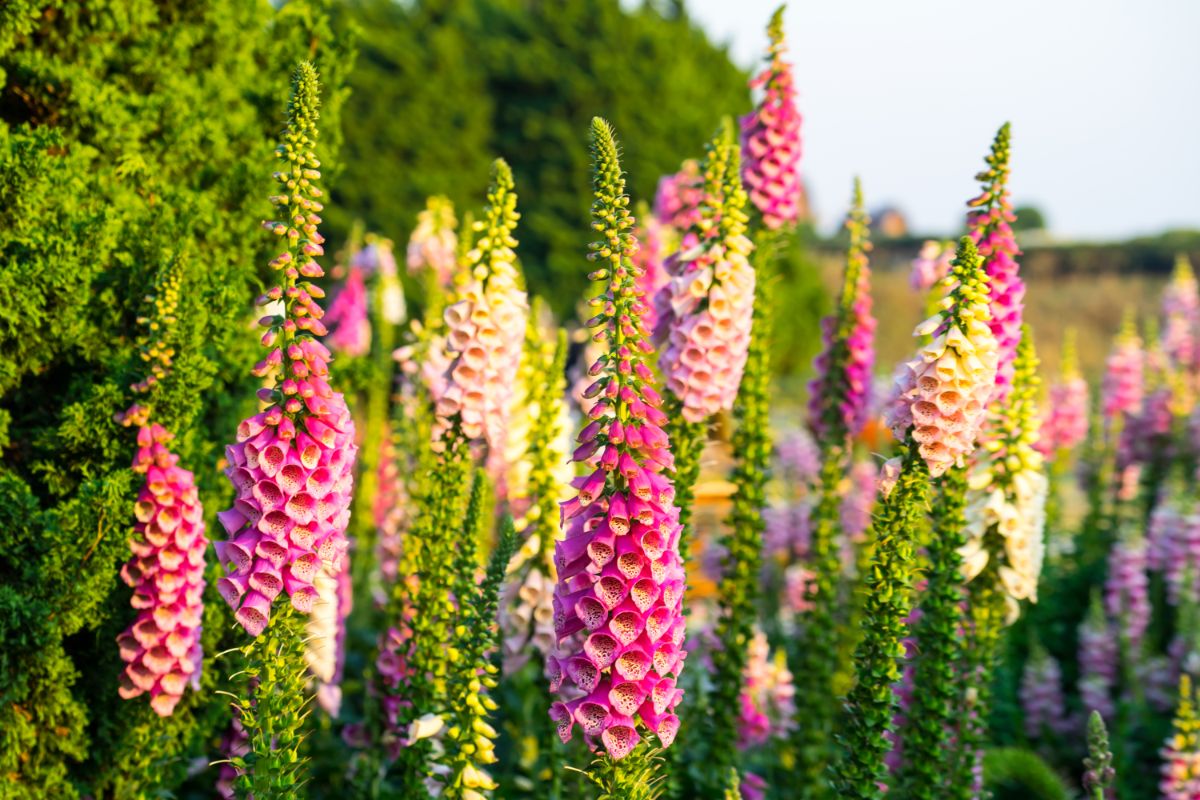
These flowers, called foxgloves, can be a welcome addition to your perennial garden. This guide will teach you how you can plant and grow them successfully.
As you might guess, given their prevalence growing in the wild, cultivating them can be just about effortless.
Jump to any section directly using the advanced jump below, or read on for our full foxgloves growing guide.
Jump to:
- What Are Foxgloves?
- Foxglove Basics
- Where Do Foxgloves Grow?
- Are Foxgloves Invasive?
- Why Grow Foxgloves?
- When Do Foxgloves Bloom?
- How Long Do Foxgloves Bloom?
- When to Plant Foxgloves
- Ideal Growing Conditions for Foxgloves
- How to Plant Foxgloves
- How to Propagate Foxgloves
- How to Care for Foxgloves
- Recommended Planting Combinations for Foxglove
- Foxglove Landscaping Ideas
- Recommended Foxglove Varieties
- Frequently Asked Questions About Growing Foxgloves
- Where to Buy Foxgloves
What Are Foxgloves?
Foxgloves are plants within the genus Digitalis. Sometimes people even simply refer to them as Digitalis. There are about 20 species, the most famous of which is Digitalis purpurea.
There are many fanciful names for foxgloves. Some of these include fairy bells, lady’s gloves, and fairy gloves.
Foxglove is quite well-known for its medicinal properties. Certain drugs, such as digoxin, contain Digitalis extract.
That does not mean you should cultivate foxglove for anything but ornamental purposes. This plant is extremely toxic, and consuming it, even in small amounts, can be fatal (see the FAQ for more info).
Foxglove Basics
| Zones: | 4-9 |
| Blooming season: | Spring and summer |
| Expected height: | Up to 6 feet |
| Soil: | Moist, well-drained |
| Sun: | Full to partial |
Where Do Foxgloves Grow?

Foxgloves are native to Europe, the northwestern part of Africa, and the western part of Asia.
Since Foxgloves are happy in climate zones 4-9, they are easily cultivated in many locations around the globe.
Are Foxgloves Invasive?
Digitalis grows and spreads easily. That means that depending on where you live, it may be considered an invasive plant. You should check local databases to find out whether or not this is the case and plan accordingly.
Why Grow Foxgloves?
Here are some reasons foxgloves can make a wonderful addition to your perennial garden:
• Dramatic blooms. The tall stalks of blooms produced by foxgloves demand attention, making for many exciting landscaping possibilities.
• Deer-resistant. If deer cause problems in your garden, you will be delighted to hear that they will not be eating your Digitalis plants. These plants are toxic to deer and also to rabbits, making them rabbit-resistant as well.
• Adaptable. Foxgloves can handle a wide range of soils. If you are having a hard time finding a plant for your sand, clay, or other soil type, foxgloves may be the answer you have been seeking.
• Easy to grow. It is extremely easy to grow Digitalis successfully. They tend to grow effortlessly along the roadside and in fields, so with a little care and attention from you, they should be very happy in your garden.
• Long bloom period. You will have months in which to enjoy the blooms of foxgloves during the growing season.
• Attract bumblebees and hummingbirds to your garden. Foxgloves are a favorite of these friendly pollinators, so planting Digitalis is a wonderful way to invite them.
• Grow cut flowers. The long stalks of blooms of Digitalis can help you create beautiful flower arrangements.
When Do Foxgloves Bloom?

Early summer is the main bloom period for Digitalis. But some foxgloves may bloom in late spring in certain locations.
How Long Do Foxgloves Bloom?
One of the best things about foxgloves is their long bloom time: up to several months. You can extend the bloom period for foxgloves by deadheading them.
When to Plant Foxgloves
Spring and fall are generally the best times of the year to plant foxgloves. We have seen some sources state that you can plant them in summer as well, but it is generally best to plant perennials when temperatures are mild. Make sure that if you plant in spring, it is after the last frost. If you plant them in the fall, do not do it too close to the first frost.
Ideal Growing Conditions for Foxgloves
It is pretty easy to keep foxgloves happy, but they will produce the most abundant blooms if you grow them in their ideal conditions. Below, we go over the sun, soil, and water requirements for Digitalis.
How Much Sun Do Foxgloves Need?
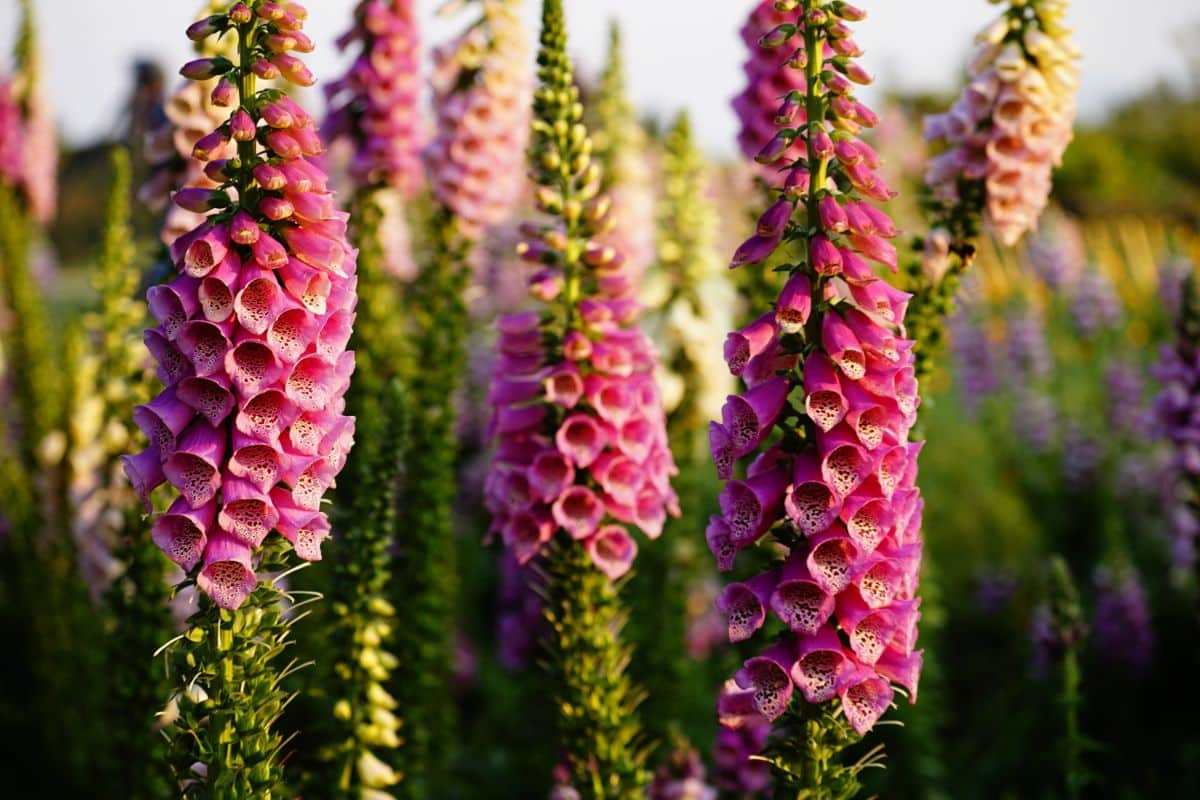
Your foxgloves will need plenty of sunlight to grow at their best. You can go with either full sun or partial shade.
If you are growing Digitalis in a hot climate, you might want to plant them where they can get some afternoon shade.
What Type of Soil is Right for Foxgloves?
What soil types are suitable for foxgloves? You should plant Digitalis in moist, well-draining soil.
Foxgloves tolerate a range of soil conditions, but they prefer soil to be rich, so you may want to amend it with organic materials.
Mixing compost into your soil is a good way to improve its drainage while enriching it at the same time.
The pH can be slightly acidic, slightly alkaline, or neutral.
Regardless of whether your soil texture is loam, clay, sand, or just about anything else, foxgloves should grow fine.
How Much Water Do Foxgloves Need?
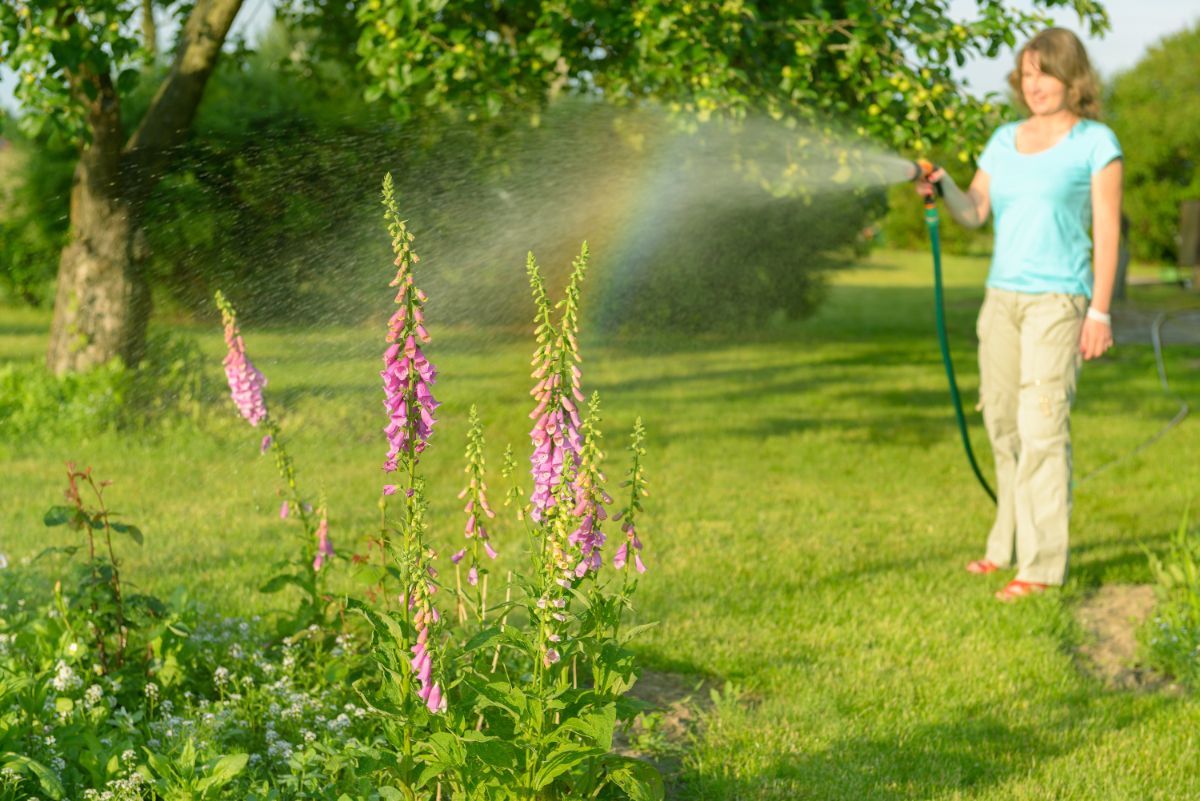
Most recommendations for watering foxgloves are the same as they are for the majority of other perennials: about an inch of water a week.
If you are getting precipitation, sometimes that is enough to water your plants. If not, you will have to water your Digitalis by hand.
Directly after you plant your foxgloves, they will need extra water while they establish. Once they are established, you can drop to a normal watering schedule.
How to Plant Foxgloves
Although you can grow foxgloves from seeds, you will probably start out with a nursery plant. Below are the directions for planting foxgloves in your flower beds or in containers.
Ground Planting
1. Pick a spot to plant your foxgloves and prep the soil. Mixing in compost can be a good idea in order to boost drainage and richness. Aged manure is another good option. If your soil is already rich and well-draining, you might be able to skip this step.
2. Make holes for the foxgloves. They should be spaced around 1-2 feet from each other to ensure airflow.
3. Plant the foxgloves and fill in the soil. The root ball and the soil surface should be at the same level.
4. Water deeply.
Container Planting

Want to add foxgloves to your container gardens? Here is how it is done:
1. Start by choosing a type of foxglove that is likely to do well in a container. There are compact varieties of this plant you can consider such as the cultivars Strawberry or Foxy.
2. Choose deep containers for your foxgloves, and add drainage holes if your pots did not come with them.
3. Put potting mix in each container.
4. Remove your Digitalis plant from the nursery container and place it inside its new home. Fill the soil around it.
5. Water well.
6. Choose a sunny spot for your foxglove container plant, possibly with afternoon shade.
How to Propagate Foxgloves
The two main propagation methods for foxgloves are by seed or from divisions. We include the instructions for both below, along with a section about cuttings.
Starting Foxgloves from Seed
Here are the instructions for growing foxgloves from seeds.
1. Get seed trays with drainage holes. Fill them with potting soil.
2. Use a spray bottle to moisten the soil. Wait for it to drain out through the bottom.
3. Sow the seeds. Every seed will need around 2 square inches of space. Set them on top, and then gently press on them so they are lodged in the soil. Do not cover them fully, or they will be unable to germinate.
4. Use the spray bottle to mist the soil again. You do not need to fully saturate the soil this time, just the surface. Mind that you do not dislodge the seeds as you do this.
5. Use a clear plastic lid or plastic wrap to cover the tray.
6. Find a spot where you can germinate the seeds. They will need warmth and light.
7. Check on the soil now and again to ensure it stays moist, using the spray bottle when needed.
8. Wait for 14-21 days. Around that time, you should see seedlings pop up.
9. Take the cover off the top so that the seedlings can keep growing without making contact with the lid.
10. Continue to moisten the soil when you need to as the seedlings continue to grow.
11. After about 6-8 weeks have passed, your seedlings will be old enough to transplant. Before you do, you will need to harden them by taking them outdoors for short and then increasingly longer periods of time, so they adapt to life outside.
Note that if it is relatively late in the season, you might not be able to take the seedlings outdoors until the following spring. If they are exposed to frost when they are very young, they will not make it through the winter. So, they will instead need larger pots so they can stay indoors until it is safe to plant them.
Starting Foxgloves from Cuttings
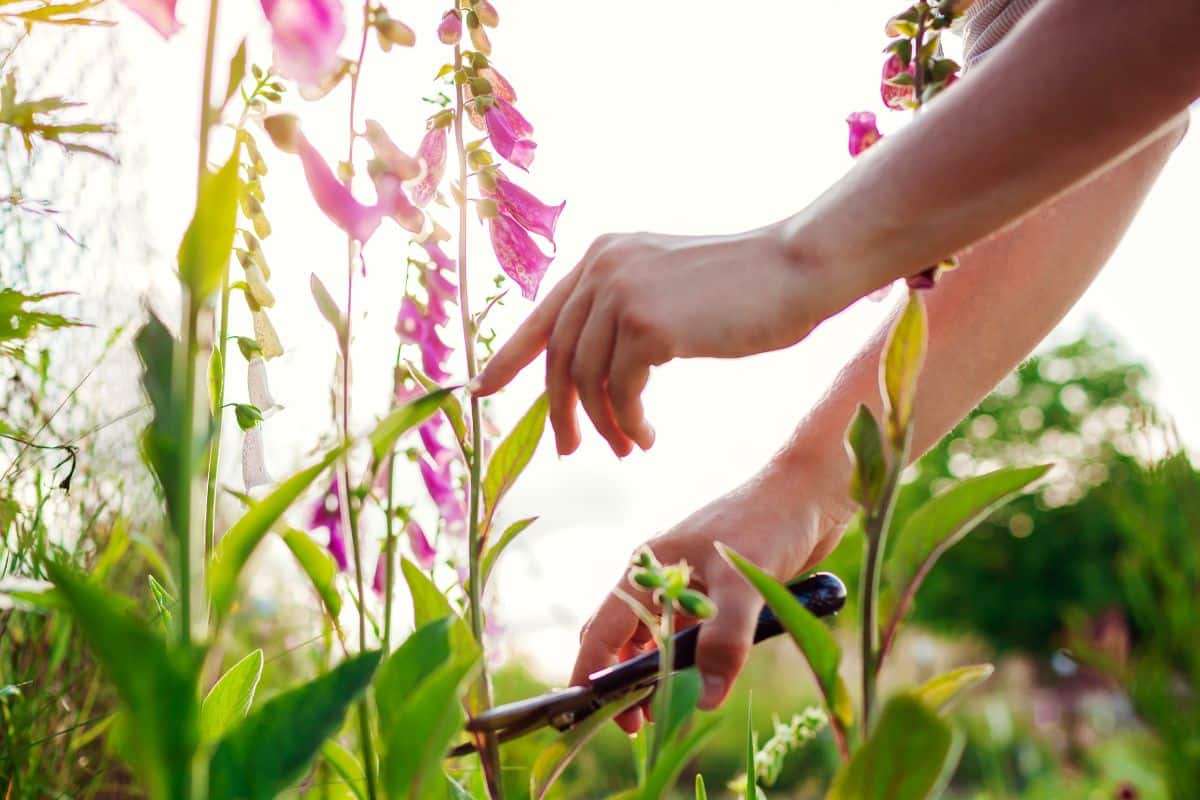
We have not seen any evidence that the typical gardener propagates foxgloves from their cuttings. That said, we also see no indication that it is impossible to do.
We suggest that you stick with propagation via other methods. But you can always give cuttings a try if you want.
If you do, just follow the standard method that is recommended for most perennials. That means:
1. Take a cutting from the plant.
2. Dip it in the rooting hormone.
3. Moisten the soil.
4. Push the cutting gently into the soil in a pot with drainage holes.
5. Cover the cutting with a clear plastic container/bag to lock in moisture, making sure it does not touch the cutting.
6. Keep moistening the soil as needed while you wait for your cutting to root.
How to Divide Foxgloves
Like most other perennials, foxgloves can be divided as a means of propagation. Here is how to do it:
1. Use a trowel to dig in a circle around the plant. Make sure that you are at least half a foot away from it so that you do not accidentally cut through the roots.
2. Once you have made a circle, you can push under the roots. Pry the plant up out of the ground.
3. Wipe away the excess dirt from the plant so you can get a better idea of what you are doing.
4. Use sanitized garden shears to divide the plant. Make sure that there are multiple roots and stems for every division. Usually, you will be able to make two or three of them.
5. Dig holes and plant your newly-divided foxgloves. Backfill the soil and water well.
How to Care for Foxgloves

Now that you know how you can plant and propagate foxgloves, it is time to take a look at what you need to do to maintain these tall spikes of beautiful blooms.
How to Fertilize Foxgloves
The best options for fertilizing foxgloves are compost and slow-release fertilizer with a formula like 5-10-5. It is important not to use a formula that is heavy on nitrogen because you will see fewer blooms if you do.
How to Mulch Foxgloves
Foxgloves are plants that will thrive when they are mulched. The main purpose of the mulch is to keep weeds from encroaching on your foxgloves. But they will also help lock moisture into the soil and keep the temperature cool and even.
How to Stake Foxgloves
Foxgloves usually stand up just fine on their own, as you have probably observed if you have ever seen them growing in the wild.
Nonetheless, they may sometimes be a bit floppy, particularly if they are subjected to high winds.
You can stake foxgloves by attaching them to bamboo stakes using garden ties. Do not tie the plants to the stakes too tightly, or you can harm them.
How to Prune Foxgloves
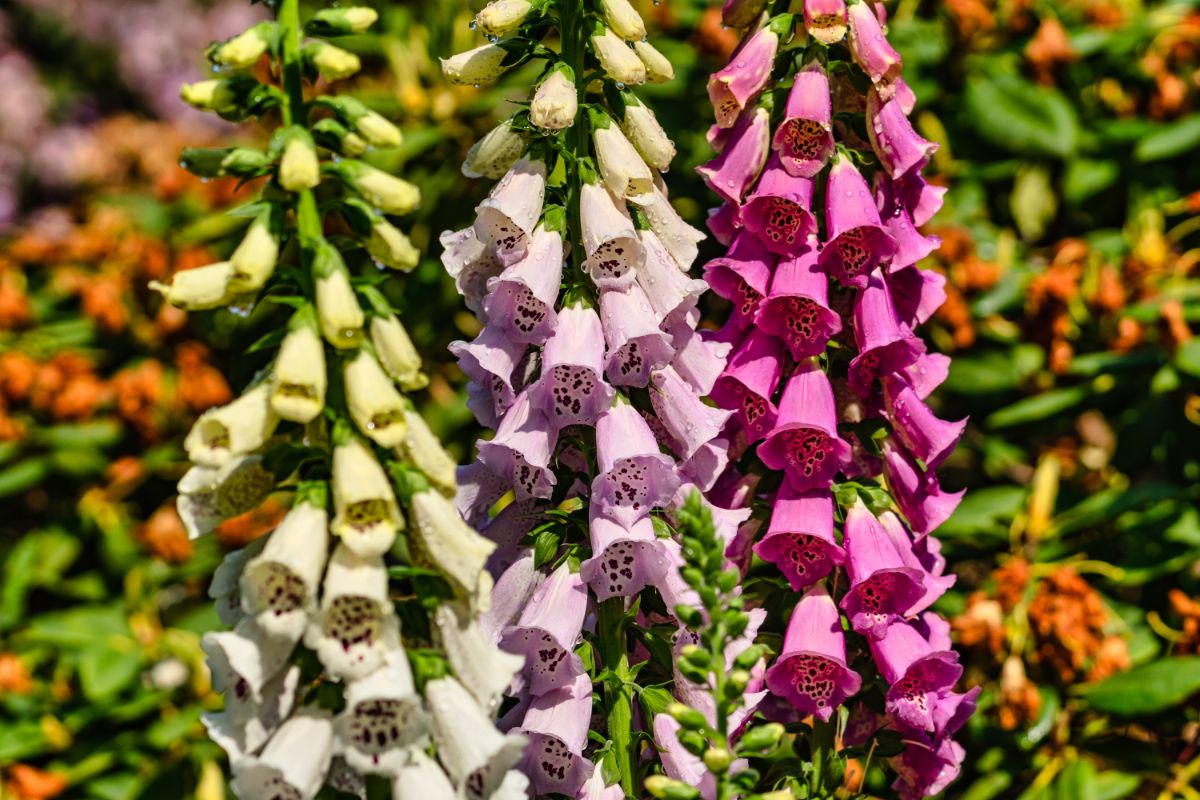
You can maintain the appearance of your foxgloves as well as their health through proper pruning. Let’s go over what you need to know about deadheading foxglove and trimming it back.
How to Deadhead Foxgloves
You are going to want to deadhead your foxgloves. Doing so can actually promote additional blooms from side spires.
Deadheading also stops foxgloves from going to seed, which is helpful if you do not wish for them to spread.
You do not deadhead foxgloves by removing individual blooms; instead, you snip off the stalks. The best time to do this is when around three-quarters of the flowers have wilted.
When to Cut Back Foxgloves
What you should do with your foxgloves at the end of the season depends on the type of foxglove you have.
If you have a biennial foxglove that has gone to seed, you can dig it up and discard it as it is done. But if you have a perennial foxglove, you can simply trim it back in fall. That way, you tidy it up while you wait to enjoy its flowers again the next year.
Do not leave the dead stalks lying around; pick them up and throw them away when you are done trimming to prevent rot and pest problems.
Have questions about biennial vs. perennial foxgloves? See the FAQ for more information.
Are Foxgloves Vulnerable to Diseases or Pests?

Like the other plants in your garden, Digitalis may sometimes contract diseases or be targeted by pests.
Some common foxglove diseases include leaf spots, Anthracnose, and powdery mildew. Many problems can be prevented simply by ensuring that your foxgloves have sufficient airflow and drainage.
The pests that can damage foxgloves include mealybugs, aphids, Japanese beetles, slugs, and snails.
Happily, deer and rabbits will usually steer clear of foxgloves since they are poisonous. You can read in detail about the toxic effects of foxglove consumption in the FAQ section of this post.
Recommended Planting Combinations for Foxglove
There are so many beautiful companion planting ideas for foxgloves. Here are some ideas to consider:
• Lupines: These plants appreciate similar conditions in terms of sun and soil as foxgloves. They also produce upright stalks of flowers, but they are shorter than foxgloves. That means that you can plant them in front of foxgloves for a breathtaking effect.
• Delphiniums: Like foxgloves, delphiniums are tall plants growing up to around 6 feet. They enjoy moist, rich, well-draining soil and full to partial sun, making them ideal companions for your foxgloves.
• Hollyhocks: If you are able to plant your foxgloves in full sun, one companion that may be very happy with them is hollyhocks. These plants grow up to 9 feet tall and, likewise, produce blooms on stalks.
Foxglove Landscaping Ideas
Here are some of the best ways to use foxgloves in your garden landscape:
• Line a fence or wall. The tall stalks of the foxgloves can conceal a boring wall or unsightly fence and bring color to an area that would otherwise be bland.
• Protect other plants. Because deer tend to avoid foxgloves, you might find it helpful to surround some other plants with them that would normally be targeted by deer for their suppers. This will not guarantee the safety of those other plants, but it could at least act as a deterrent.
• Increase privacy. Foxgloves are just tall enough to provide you with a little bit of extra privacy from your neighbors when the stalks are in bloom. They certainly do not replace a more permanent privacy screen, but they help a little.
• Plant in a cottage garden. Perennial flowers that grow on tall stalks are a classic fixture of a cottage garden, and foxgloves can fill this role nicely.
• Grow in a wildflower garden. It is common to see foxgloves in the wilderness, so they naturally lend well to a wildflower garden that you want to have a somewhat wild, free appearance.
• Add color to a woodland garden. Foxgloves can grow well in partial sun, and may be quite happy in the dappled light of a woodland garden.
• Mass them together. A mass of these tall stalks with their beautiful blooms can have a dramatic effect.
Recommended Foxglove Varieties
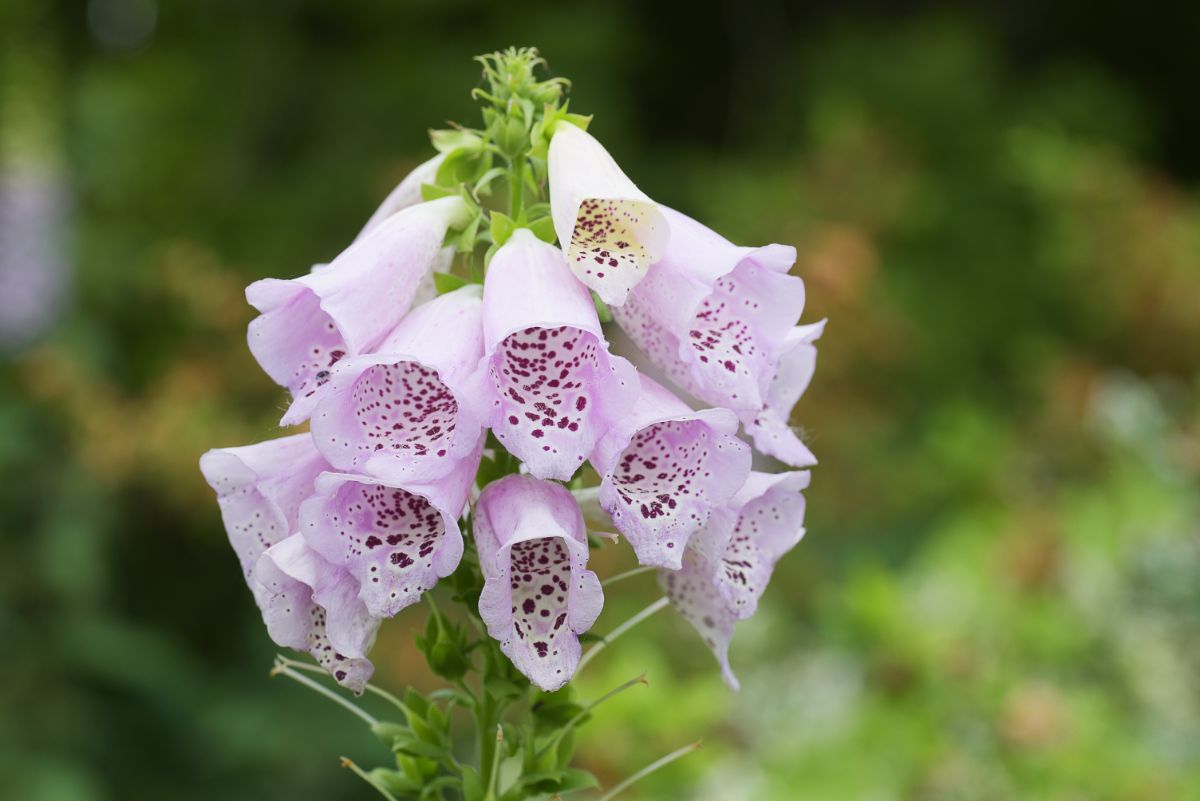
What are some of the most beautiful cultivars of foxgloves? Let’s take a look at some lovely options to consider for your garden.
• Candy Mountain Foxglove: You can plant this cultivar for a vibrant display of deep pink flowers. It is a type of Digitalis purpurea, which makes it a biennial. It blooms in late spring and early summer.
• Foxy Hybrids: This is one of the types of foxglove that is relatively compact, making a good option for container gardens. They also can be happy in woodland gardens. The flowers have a variety of colors, including pink, cream, yellow, white, and purple. Many people particularly like to cut them for bouquets and arrangements. Their smaller size makes them perfect for this purpose.
• Dalmatian Rose: For foxgloves with a rosy color, look no further than this fantastic cultivar that blooms in late spring.
• Dalmatian Peach: Birds, bees, hummingbirds, and butterflies will all flock to the gorgeous blooms of this cultivar. The blooms are pink when they first open, but later, they turn a peachy hue.
• Rusty Foxglove: This name refers to a specific species of foxglove, Digitalis ferruginea. It produces flowers as early as May and continues through June. The color of the blooms looks a bit “rusty,” thus the name.
• Milk Chocolate Foxglove: Another species of foxglove that has a fun colloquial name is this one, Digitalis parviflora. The blooms are a brownish-orangey color and are quite narrow, giving it a distinctive appearance.
• Arctic Fox Rose: You might expect a foxglove with a name like “Arctic Fox Rose” would have some white in it, but it really is the “Rose” part of the name that describes the blooms well. The hybrid produces flowers that are pink and peach. The bloom time is especially long, starting in April and going all the way to September. Another advantage of this cultivar is that it is a proper perennial rather than just a biennial. So, you can look forward to years of delight from this plant.
• Illumination Flame: One particularly striking cultivar of Digitalis to add to your garden is this one, named for the fiery colors of its distinctive blooms. While most foxglove blooms droop downward a bit, these ones do not. That means you get a really unique look when you plant this cultivar in your garden.
• Strawberry: Another lovely cultivar to plant if you want pink flowers is this one, aptly named for the appearance of its blooms. Because it is pretty compact, it does well in pots.
• Polkadot Princess: What stands out about this cultivar is just how densely the deep pink flowers are packed on each stalk.
• Excelsior: This hybrid is a summer favorite and produces flowers in varying hues.
• Camelot Lavender: If you want a classic purplish foxglove, try planting this gorgeous cultivar. It is another one that pollinators in your garden will adore.
• Alba: If you want to grow a type of foxglove that produces white flowers, this is the cultivar for you. Note that the flowers are not 100% white; like other types of foxgloves, the blooms have spots in their throats.
• Apricot Beauty: Another option for foxgloves with peachy flowers is this cultivar. The summer blooms will attract bees and other pollinators and delight you with their warm colors.
• Merton: This type of foxglove produces flowers in a rosy hue. It is a great option for attracting pollinators and for producing a second flush of blossoms.
Online, you can find these and other varieties of foxgloves to enjoy. Your local nursery may carry a few cultivars, but not as many as you are going to find through online nurseries.
Frequently Asked Questions About Growing Foxgloves
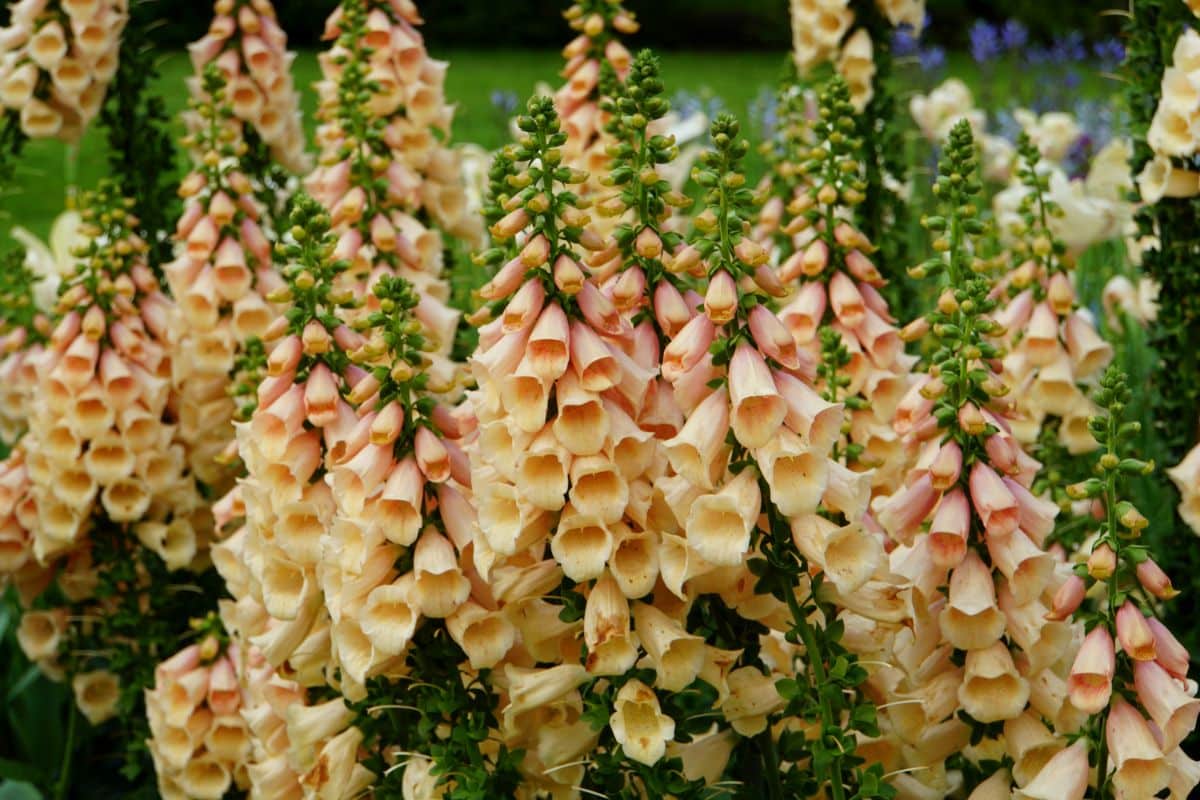
Now you know all about how to grow foxgloves successfully. Here are answers to a few more questions you might have about Digitalis.
Insects, slugs, and snails sometimes eat foxgloves. Mammals usually do not since it can kill them.
Absolutely not. You must never eat any part of a foxglove plant. See below for an explanation of why this is so important.
Yes, foxgloves are poisonous to cats, dogs, horses, and humans. And they are not just a little toxic either—they are notoriously deadly.
Have you ever watched the James Bond movie Casino Royale? You might recall that when Bond is poisoned in the middle of a Texas Hold’em game, it is with Digitalis.
In small, controlled amounts, Digitalis is medicinal. But the leaves, stems, seeds, and flowers can all produce a toxic reaction in the wrong dosage.
The National Capital Poison Center explains, “When formulated into a medication with a controlled dosage, digitalis is valuable in treating heart failure. It helps a weakened heart pump harder. People who eat any part of the plant or make tea from the leaves are, in essence, taking an unregulated dose of heart medicine. This can cause the heart rate to slow down or become irregular. Both can be dangerous and life-threatening.”
The National Capital Poison Center adds that children are sometimes susceptible to Digitalis poisoning because the flowers and berries are pretty and colorful. They look tasty, so children may try to eat them.
So, if you grow Digitalis and you have kids, you should try to keep them away from your foxgloves. Needless to say, you also should keep your pets from going anywhere near them.
Here are the signs and symptoms of Digitalis poisoning so you know what to look out for:
• Slow heartbeat
• Irregular heartbeat
• Low blood pressure
• Collapse
• Confusion
• Blurred vision
• Disorientation
• Depression
• Hallucinations
• Lethargy
• Headache
• Lost appetite
• Halos in vision
• Rash
• Hives
• GI symptoms
• Weakness
• Drowsiness
If you think you, your child, or your pet has been poisoned by Digitalis, you need to seek immediate medical care, as it is a life-threatening emergency.
Foxgloves are short-lived perennials. That means they produce flowers for a few years.
Gardens Illustrated says, “The only true biennial is Digitalis purpurea and its cultivars, although some modern purpurea foxglove hybrids are classed as short-lived perennials. Most foxgloves, including ancient species and modern hybrids, are perennials, whose lifespan varies according to the growing conditions but is usually three to five years.”
The article continues, “Perennial foxglove species are divided into two groups: herbaceous perennials, such as Digitalis grandiflora and Digitalis lutea, which die down during cold winters, and those retaining an evergreen rosette, including Digitalis parviflora and Digitalis ferruginea.”
Many people are under the impression that Digitalis plants are all biennials, but now you know better.
Where to Buy Foxgloves
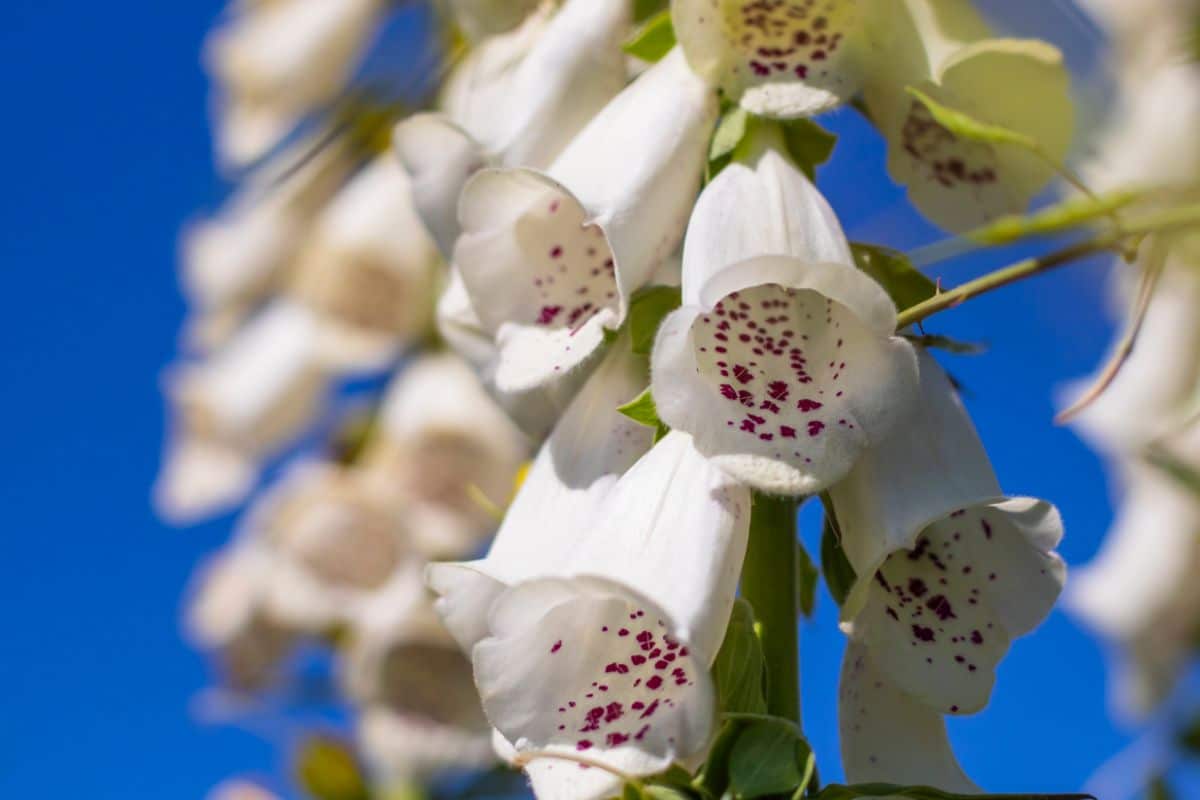
With their tall flower stalks and easy care and maintenance, foxgloves may be just the addition you are looking for to your perennial garden. Click below to shop foxgloves online now.









Leave a Reply